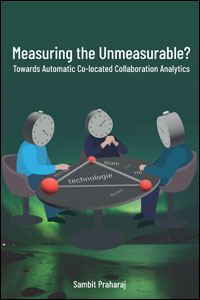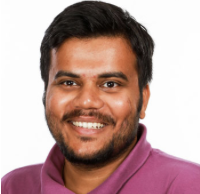 Collaboration is one of the most important skills in the 21st century. Education, therefore, focuses on learning to cooperate, both in online and face-to-face settings. Learning Analytics is increasingly being used to analyse collaborations. Can face-to-face collaborations be analysed automatically by means of sensor technology? And what is the quality of the analyses generated by this? Sambit Praharaj developed a technical prototype to achieve automated collaboration analytics.
Collaboration is one of the most important skills in the 21st century. Education, therefore, focuses on learning to cooperate, both in online and face-to-face settings. Learning Analytics is increasingly being used to analyse collaborations. Can face-to-face collaborations be analysed automatically by means of sensor technology? And what is the quality of the analyses generated by this? Sambit Praharaj developed a technical prototype to achieve automated collaboration analytics.
On Friday 11 March 2022 at 1.30 pm Sambit defended his thesis ‘Measuring the Unmeasurable? Towards Automatic Co-located Collaboration Analytics‘ at the Open University in Heerlen.
Collaboration analytics using sensor technology
Sambit Praharaj investigated the possibilities of automating collaboration analytics in face-to-face settings. He developed a prototype that measures the quality of collaboration. Praharaj also developed a dashboard that visualises the data and provides insight into the quality of collaboration for the teacher and group members.
Communication in a face-to-face collaboration
Face-to-face collaboration takes place at the intersection of the physical, social and epistemic space of the group members in collaboration. The social space includes the non-verbal indicators, such as posture, gesture and eye gaze; and non-verbal audio indicators, such as speaking time, pitch and taking a turn. The epistemic space includes the verbal audio indicators, such as the content of the conversation. The quality of collaboration can be detected using sensor technology that picks up signals in these different spaces. Sambit Praharaj’s research focuses on auditory indicators.
Research results
 Sambit Praharaj’s research and developed dashboard can be used by teachers for small group settings and larger settings, such as classrooms. The research shows that the quality of the analyses depends on the scenario in which collaboration takes place, for example, brainstorming, gaming or programming. Collaborative analytics cannot be fully automated, as a person must be involved to provide context and clean up data prior to analysis. The audio of group members generates a lot of data, whereby the focus in the analysis is on how someone speaks, such as speaking time and pitch. By putting more focus in follow-up research on the content of what the group members say, instead of how they speak, more holistic insight into the process may emerge. The complete thesis can be found online here.
Sambit Praharaj’s research and developed dashboard can be used by teachers for small group settings and larger settings, such as classrooms. The research shows that the quality of the analyses depends on the scenario in which collaboration takes place, for example, brainstorming, gaming or programming. Collaborative analytics cannot be fully automated, as a person must be involved to provide context and clean up data prior to analysis. The audio of group members generates a lot of data, whereby the focus in the analysis is on how someone speaks, such as speaking time and pitch. By putting more focus in follow-up research on the content of what the group members say, instead of how they speak, more holistic insight into the process may emerge. The complete thesis can be found online here.
Promotion Sambit Praharaj
Sambit Praharaj (1993, Rourkela, India) holds a PhD from the faculty of Educational Sciences of the Open University. He defends his thesis ‘Measuring the Unmeasurable? Towards Automatic Co-located Collaboration Analytics’ at the Open University in Heerlen. His supervisors are Prof. Dr. Hendrik Drachsler, Open University and Prof. Dr. Marcus Specht, Delft University of Technology. Co-supervisor is Prof. Maren Scheffel, Ruhr-Universität Bochum.
